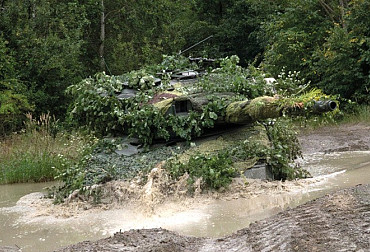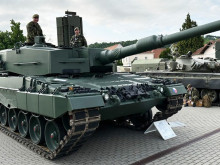New STARKOM jammers significantly enhance 532nd Electronic Warfare Battalion capabilities
The Army of the Czech Republic or the 532nd Electronic Warfare Battalion (532. prEB) will receive a total of 8 new STARKOM mobile communication jammers as part of its modernisation. This system on a Tatra Force 8×8 chassis with several masts with antenna systems can, for example, interfere with the adversary's radio communications, its command and control systems or air communications. In order to obtain more information not only about the STARKOM system, but also about the overall capabilities of the 532nd Electronic Warfare Battalion, we personally visited this Opava unit.
Video: Report from our visit to the 532nd Electronic Warfare Battalion | CZ DEFENCE
Throughout our visit, we were attended directly by the commander of the 532nd prEB, Colonel Lukáš Hoza, who first introduced the unit itself, its capabilities and equipment. The battalion, which consists of four EW (Electromagnetic Warfare) companies and one logistics company, is tasked with electromagnetic warfare tasks related to electromagnetic support measures and electromagnetic countermeasures. In particular, this involves conducting electromagnetic monitoring of communication and non-communication emitters in the electromagnetic spectrum, conducting electromagnetic attack on C3 systems (Command, Control, Communications) of headquarters and manoeuvre units and support in information operations, etc. Of course, the battalion is not only engaged in electromagnetic attacks, but can also conduct electromagnetic defence of its own forces in the form of disrupting enemy C3 systems, countering radio-launched IEDs (improvised explosive devices), drones and precision weapons. This defensive activity also includes detecting the presence of enemy emitters and their location. Another mission of the 532nd Electronic Warfare Battalion is also to support the Air Force, where the battalion contributes to the overall air situational awareness, for example.

Within the framework of electromagnetic warfare, the battalion specifically provides search, interception, identification and localization of enemy emitters, to which it then applies electromagnetic countermeasures in the form of jamming and deception, if necessary. In electromagnetic defense, the 532nd prEB employs active or passive electromagnetic countermeasures, where active countermeasures are detectable by the enemy and passive countermeasures are not. The battalion is able to co-operate with other units when required, such as the 533rd Unmanned Systems Battalion, which also falls, like the 532nd prEB, under the 53rd Reconnaissance and Electronic Warfare Regiment, and realistically all these capabilities are implemented under the ISR modular unit.
The importance and need for the 532nd prEB's capabilities continues to grow, as there is virtually no force type in the Army today that does not use radio transmission, the disruption of which by the enemy could have fatal consequences on the battlefield.
The battalion currently employs equipment providing electromagnetic support measures, such as the older RUP-FM-M passive reconnaissance system and the RZ-12 mobile electronic warfare sets and radio direction finders in the field of communications. In the non-communication area, the battalion has at its disposal, for example, the passive tracking system Vera S/M (which are currently being replaced by modern passive tracking systems DPET), long-range stations (SDD), directional radio-technical searchlight (SRTP), etc. Electromagnetic countermeasures are provided by the older mobile KV jammer (MKVR), STAR V series jammers or the new mobile STARKOM jammers.

It was the STARKOM jammer that we were most interested in, as it is a truly unique and very powerful system that greatly enhances the existing capabilities of the 532nd Electronic Warfare Battalion. STARKOM is designed to detect and jam tactical phonic and data radio links in the VHF, UKV and SKV bands. The jammer is able to operate effectively against enemy vehicle or handheld radios, provides anti-drone protection, can jam Global Navigation Satellite System (GNSS) or airborne communications links (in air bands 1 and 2), and can jam GSM networks or military C2 (Command and Control) systems if required.

The frequency range of the jammer is VHF-SKV with a total power of 2490 W. The STARKOM mobile jammer has its own power supply and is thus energy self-sufficient. The vehicle crew and sensitive electronics (cabin and superstructure) are protected by mine and ballistic protection at K2 and M1 levels. The jammer crew is also protected against CBRN (Chemical, Biological, Radiological, and Nuclear) threats. In addition, the FN Minimi armoured machine gun, located on the roof of the vehicle's armoured cab, is used for direct crew protection. The entire vehicle is also protected by multispectral mobile camouflage in the visible, infrared and microwave regions. The mobile jammer can be transported on its own axis, by rail, or it can be transported by e.g. Antonov An-124-100 or Boeing C-17 Globemaster III transport aircraft. The STARKOM jammer is fully autonomous as far as other escorts are concerned and carries everything with it, so it does not need any additional support apart from refuelling. The full development of the jammer into an operational state takes only a few minutes, and in the case of operational deployment, STARKOM is then capable of continuous operation for tens of hours. The STARKOM jammer operator is capable of 100% availability.
Although the new STARKOM jammer is newly introduced in the 532nd Electronic Warfare Battalion, future software support (update) and technical evaluation (hardware) are already foreseen, as with other newly introduced systems in the Czech Armed Forces.

As part of our visit, we asked the commander of the 532nd prEB, Colonel Lukáš Hoza, the following questions:
Jamming in the radio spectrum is basically "overwriting" the original (enemy) signal with a stronger signal, which reveals the position of the jammer to the enemy. How do you solve this problem?
We are aware of this risk. We anticipate it and take a number of organizational and technical measures to mitigate it.
Is it possible to say which all electromagnetic and other spectrums can be monitored, within the framework of passive surveillance means?
Basically, the first limitation is physics - the propagation of the electromagnetic wave and, in particular, its attenuation in the atmosphere. Another practical limitation is the tactical applicability of the information thus obtained. Generally speaking, the whole range from long wave (some types of communications) to ultraviolet radiation (MWS - Missile Warning System) depends on the purpose and task.
What all are you able to find out about the enemy in electromagnetic support measures? Certainly not just the existence of an enemy transmitter and its position. To what extent, then, will the Army's future acquisition of F-35s enhance these capabilities?
Quite undoubtedly, like all EW assets, they must be viewed as part of the whole. EW sensors searching in the EMS have a direct relationship to effectors - i.e., assets that are active in the spectrum. The information obtained by EW sensors then, in parallel, when further processed and integrated into the overall picture, enhances situational awareness and contributes to a range of processes, including targeting.
The EW assets integrated in the F-35 (AN/ASQ-239) are primarily intended for electromagnetic (ED) defence of the aircraft itself, but also contribute to early warning of threats, situational awareness and support the targeting process. As such, they undoubtedly contribute to the high capability of both the aircraft itself and the effectiveness of the tactical activities it performs and supports. The data obtained by this EW system, integrated into a coherent information system, can then significantly influence the course of the conducted operation.
How closely must the 532nd prEB work with, for example, the Cyber Forces and Information Operations (KySIO) group?
Conducting electromagnetic warfare as part of combat support requires integration into a wide range of activities and very close cooperation with all elements operating in the EMS (Electromagnetic Spectrum, editor's note) as part of so-called electromagnetic operations. This primarily concerns frequency spectrum management, information and communication systems and then all elements that use the EME (Electromagnetic Environment) for their activities. In addition, electromagnetic warfare assets can provide both information and effectors for potential cyber and information operations, navigation warfare, counter-unmanned aerial vehicle warfare and other activities. That is, if necessary, the 532nd prEB will cooperate with both the KySIO and other elements of the ACR. However, it should be remembered that the 532nd prEB is only an executive element. Proper and effective integration of electromagnetic warfare requires cooperation at all levels-from strategic, to operational, to the lowest tactical levels-and all must cooperate with their counterparts at those levels.
The STARKOM mobile jammer is mounted on a special Tatra Force 8x8 chassis. Can this system perform jamming even when moving, i.e. while moving, or does the jammer have to be static? To what extent, if any, does the movement of the STARKOM vehicle affect the quality of the jamming?
The jammer is capable of operating in motion and, in general, it can be concluded that the quality of the jamming is not affected.
The operation of STARKOM jammers has to be very professional and specialised. Can similar expertise be achieved in the civilian sector or does the military have to train itself? How long does it take to train such operators?
Basic training takes approximately 3 months of net time, followed by never-ending refresher and, for some, extension training. Next, some operators undergo driver training to retrain them on the specifics of the vehicle. All soldiers must then have mastered the basics of all-military, professional and specialty training.

How many people is the STARKOM jammer crew? What is the ratio of the automation of the traffic management to the physical operation of the jammer?
There are four operators. With the increasing demands of the contemporary and future battlefield on EW technology, the level of automation is naturally increasing. The STARKOM asset allows for autonomous response to known threats. However, the operator's role becomes more important in an unknown environment where adversary threats and assets are unknown.
Our passive surveillance assets have always been among the world's best. Is this statement still true today in terms of the capabilities and performance of Czech systems? Which of their capabilities would you highlight?
It would be easy to claim that our assets are among the world's best. It should be borne in mind that the EW field is considered very sensitive and therefore it is almost impossible to have information about the real level of resources in the world. Therefore, it is not possible to compare our resources objectively.
For individual assets, it is not about superlatives in individual parameters, but about the ability to support the tactical activities of the units and the operations conducted in all the required areas, and we are more or less succeeding in this. What puts us in an advantageous position is that, unlike many Western countries, our ground forces have managed to maintain EW capabilities in almost their entirety in the past, thus retaining the know-how and thus having something to build on (although even here there has been a downturn in this area as the armed forces have responded to the demands of operations conducted in e.g. Afghanistan or Iraq and have struggled to make ends meet on a very limited budget). This has resulted in, for example, the STARKOM asset. Just defining the requirements for new assets is almost impossible without this know-how.
I can also mention that the Czech Republic has excelled in ground-based time-lapse systems (PELS - Precision Emitter Location System) since the Warsaw Pact, such as the long-obsolete Tamara and today's DPET.
What civilian education is optimal for your unit, or in which "waters" do you recruit new candidates?
Candidates with an electrical engineering background or a background in IT or other technical disciplines are best suited. However, a broader range of skills is also needed in the EW field, but personnel without such a background can also be employed here, but they must be able to meet the relatively broad requirements of the department's training, be proactive and capable of independent thinking.
Regarding practical experience with the STARKOM system, we asked the commander of the electronic attack platoon, Lieutenant D. F., about the following:
The STARKOM jammer has already participated in several exercises. What is your practical experience with this modern system?
It is a new technique that brings facilitation of existing capabilities and possibilities completely new. In the exercises the jammer fulfilled all the required tasks, so we are satisfied with the technology. For the operators of the new jammer, it is an easier system to build and operate, which saves time and allows the operators to focus more on their other activities.
How long do you think it will take operators to fully operate the modern STARKOM system?
The basic operation of the equipment can be mastered within a week as part of intensive training, but it can logically take years to train an operator who works in an electromagnetic environment with many types of signals.
What about your participation in each exercise? Based on the fact that you always work in an electromagnetic environment when working with radios, etc., shouldn't you always participate in these exercises?
Although each exercise is focused on something different, you are correct that the assets used by almost any Army unit have to do with the electromagnetic spectrum, which is our area of interest. We don't participate in every exercise, but we certainly have a presence in the more complex exercises. Then, of course, there are exercises that are aimed directly at our expertise, and of course we participate in those as well.
Does the STARKOM jammer get along with similar systems in other alliance armies?
The STARKOM system was built from the beginning to be compatible with communications systems within NATO. So we are using more or less the same technology as our allies.
The operation of a modern STARKOM jammer requires specific and high expertise from the operators, and high demands are placed on the members of the entire 532nd Electronic Warfare Battalion. What specifically led you to this expertise?
You're right, it's not a common expertise. I personally acquired it by studying at the University of Defence, where I studied directly in the field of electronic warfare and radar, which I enjoy. And that's probably the most important thing. Later on in the battalion, I was also able to practically test my existing skills, for example by working with the new STARKOM jammer, which allowed me to push my existing skills further.





















